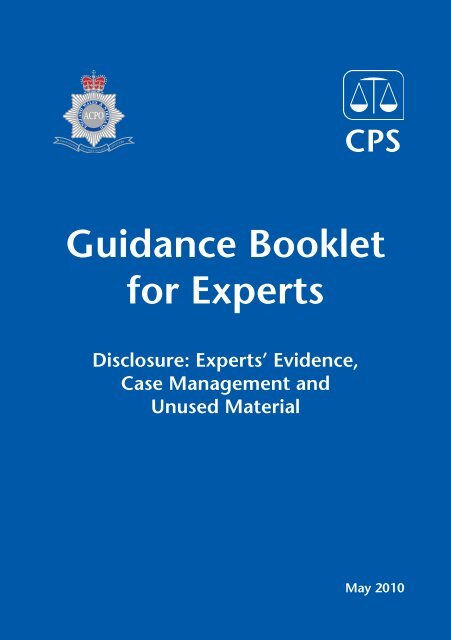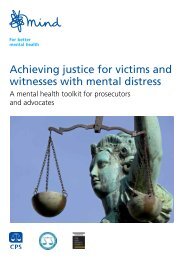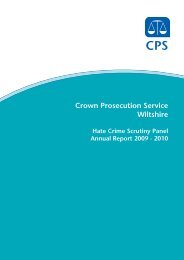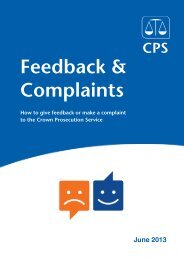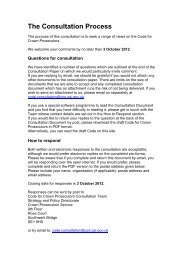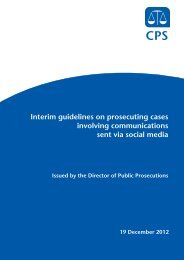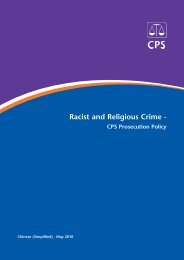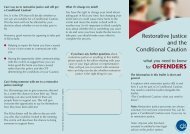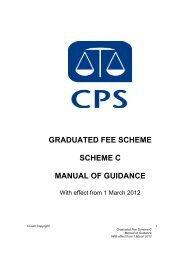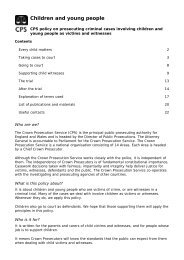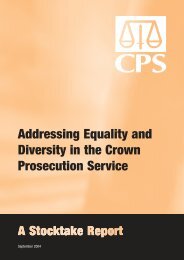CPS Guidance Booklet for Experts Witness - Crown Prosecution ...
CPS Guidance Booklet for Experts Witness - Crown Prosecution ...
CPS Guidance Booklet for Experts Witness - Crown Prosecution ...
- No tags were found...
You also want an ePaper? Increase the reach of your titles
YUMPU automatically turns print PDFs into web optimized ePapers that Google loves.
<strong>Guidance</strong> <strong>Booklet</strong><strong>for</strong> <strong>Experts</strong>Disclosure: <strong>Experts</strong>’ Evidence,Case Management andUnused MaterialMay 2010
<strong>Guidance</strong> <strong>Booklet</strong> <strong>for</strong> <strong>Experts</strong>ContentsForeword 3Introduction 5Criminal Procedure Rules: <strong>Guidance</strong> on the Overriding Objective 6Disclosure obligations under the criminal law 8Discharging your obligations 10Declaration of understanding 16The Expert’s self-certificate 16The <strong>Experts</strong>’ revelation process flowchart 17Essential case management: Applying the CriminalProcedure Rules 17Queries 17Appendix A: Expert’s index of unused material 18Appendix B: Declaration 20Appendix C: Expert witnesses self-certificate 21Appendix D: <strong>Experts</strong>’ revelation process 24Appendix E: <strong>Guidance</strong> from Lord Justice Leveson when hewas the Senior Presiding Judge <strong>for</strong> England and Wales,December 2009 261
<strong>Guidance</strong> <strong>Booklet</strong> <strong>for</strong> <strong>Experts</strong>ForewordBy Keir Starmer QC, Director of Public <strong>Prosecution</strong>s(<strong>CPS</strong>) and Jim Barker-McCardle (ACPO) on behalf ofthe <strong>Prosecution</strong> TeamThe scheme set out in the Criminal Procedure and Investigations Act1996 (‘the CPIA’) as amended by the Criminal Justice Act 2003 andthe revised Code of Practice issued under it (‘the Code’) is designed toensure that there is a fair system <strong>for</strong> the disclosure of unused material,which assists the defence in the timely preparation and presentationof its case, does not overburden the parties and enables the courtto focus on all the important issues in the trial. This endeavour issupported by compliance with the requirements of the ConsolidatedCriminal Procedure Rules 2010 (available from the Ministry of Justicewebsite: www.justice.gov.uk ).The instructions contained in this booklet are designed to providea practical guide to preparing expert evidence and the disclosureobligations <strong>for</strong> expert witnesses instructed by the <strong>Prosecution</strong> Team.When properly applied, these instructions will assist expert witnesses,investigators and prosecutors to per<strong>for</strong>m their disclosure dutieseffectively fairly and justly, which is vitally important to the integrity ofthe criminal justice system.The considered application of this guidance and appropriatemanagement of the materials within the investigation by experts willenhance their credibility and promote confidence in the role of theexpert witness within the prosecution process.2
<strong>Guidance</strong> <strong>Booklet</strong> <strong>for</strong> <strong>Experts</strong>This booklet reflects the commitment of the <strong>Prosecution</strong> Team toworking alongside expert witnesses and other agencies to ensure thatcase management and disclosure requirements are complied with fairlyand properly.Keir Starmer QCDirector of Public <strong>Prosecution</strong>sJim Barker-McCardleChief Constable, Essex PoliceOn behalf of the Association ofChief Police Officers3
<strong>Guidance</strong> <strong>Booklet</strong> <strong>for</strong> <strong>Experts</strong>4
<strong>Guidance</strong> <strong>Booklet</strong> <strong>for</strong> <strong>Experts</strong>1. IntroductionYou are instructed by the <strong>Prosecution</strong> Team, which comprisesthe Police and the <strong>Crown</strong> <strong>Prosecution</strong> Service, as an expert inthis investigation. It is important that you understand theobligations placed upon you by this status. As an expertwitness you have an overriding duty to assist the court and,in this respect, your duty is to the court and not to the<strong>Prosecution</strong> Team instructing you. This will include obligationsrelating to disclosure.The obligations which apply to you as an expert are to assistin ensuring that the <strong>Prosecution</strong> Team can comply fully withtheir statutory disclosure obligations. These obligations takeprecedence over any internal codes of practice or otherstandards set by any professional organisations to which youmay belong. Your obligations are set out in part four of thisbooklet, but can be summarised in the key actions of retain,record and reveal.A failure to comply with the guidelines in this booklet mayhave a number of adverse consequences which could include:• A prosecution being halted or delayed;• The appellate courts finding that a conviction is unsafe;• The tribunal making an adverse judicial comment aboutyou as an expert. Such an adverse judicial comment couldseriously undermine your credibility as an expert andconsequently your fitness to be instructed in future cases;• Professional embarrassment, including possible action bya professional body, loss of accreditation and the potential<strong>for</strong> civil action by an accused.5
<strong>Guidance</strong> <strong>Booklet</strong> <strong>for</strong> <strong>Experts</strong>Conversely, your credibility as an expert will be enhancedby the considered application of this guidance and yourappropriate management of the materials within theinvestigation.An expert employed by the police is not a third party and isalready required to comply with the Criminal Procedure andInvestigations Act 1996 and should comply with the detailedguidance in the Disclosure Manual (see below).2. Criminal Procedure Rules: <strong>Guidance</strong>on the Overriding ObjectivePart 12.1 The overriding objective, which is at the heart of the CriminalProcedure Rules (CrimPR), is that criminal cases be dealt withjustly. The presumption of innocence and a robust adversarialprocess are essential features of the legal tradition in Englandand Wales and of the defendant’s right to a fair trial. Theoverriding objective acknowledges those rights. It is notjustice that questions of guilt or innocence are determined byprocedural manoeuvres. On the contrary, justice is best servedwhen the issues between the parties are identified as earlyand as clearly as possible.2.2 What does dealing with the case justly mean?6Dealing with cases justly requires the court to consider thosefactors listed in Rule 1.1(2) of the CrimPR. This means that thecourt must be alert to the needs of everyone involved in acase. That includes, but it is not limited to, the interests of thedefendant (including rights under Article 6 ECHR). It extendsto the prosecution (entitled to a reasonable opportunity to
<strong>Guidance</strong> <strong>Booklet</strong> <strong>for</strong> <strong>Experts</strong>present the evidence against the defendant), the complainant,to every witness (whichever side is to call the witness), andin the <strong>Crown</strong> Court to the jury, or if the jury has not beensworn, to jurors in waiting, and to the needs of other cases.Finally, the court should not overlook the community's interestthat justice should be done without unnecessary delay. A fairbalance has to be struck between all these interests.2.3 What is the duty of a participant?All participants have a duty to deal with cases justly.Participants must ensure that they take or do any step whichfurthers the overriding objective. This means taking positiveaction to identify to the parties and the court any significantfailure which will hinder the trial process. This duty extendsto co-operating with each other and the court.2.4 Who is a participant?A participant is anyone who is involved in any way withthe case. This includes the parties to the proceedings (theprosecuting authority and defendant) and extends to otherssuch as the police, witnesses (prosecution and defence),defence representatives, court staff, jurors, custodial services,probation services and judges.2.5 How should the courts apply the overridingobjective?The court must further the overriding objective in exercisingany power given it by legislation (including any rule), practicedirection or in interpreting any rule or practice direction.The “overriding objective” is not only a statement of thecomponents which the court must take into account in7
<strong>Guidance</strong> <strong>Booklet</strong> <strong>for</strong> <strong>Experts</strong>Part 3exercising its extensive discretion when applying the CrimPRbut is also the major aid to interpreting the CrimPR themselves.Further, the objective of “dealing with cases justly” overridesevery other provision in the rules such that if another rule is,in its application to any particular case, considered by thecourt to prevent the court from dealing with that case justly,then the overriding objective will prevail.2.6 Parties must actively assist the court in furthering theoverriding objective by complying with the case managementprocess set out in CrimPR (Rule 3.1–3.11). Appendix E of thisbooklet sets out the requirements in more detail.Part 332.7 This section of the CrimPR (Rule 33.1–33.9) sets out theobligations, processes to be applied and duties of Expertwitnesses. Full details can be found at:www.justice.gov.uk/criminal/procrules_fin/rulesmenu.htm3. Disclosure obligations under thecriminal law3.1 Aims of disclosure8The regime <strong>for</strong> disclosure is set out in the CPIA and the Codeissued under it. This is designed to ensure that there is a fairsystem <strong>for</strong> the disclosure of unused material which assiststhe defence in the timely preparation of its case, does notoverburden the parties and enables the court to focus onall the important issues in the trial.
<strong>Guidance</strong> <strong>Booklet</strong> <strong>for</strong> <strong>Experts</strong>3.2 The meaning of unused materialDuring the course of any investigation material is generated.Some of it is used as evidence and other material is not used.The material that is not used as evidence is known as unusedmaterial, to which the disclosure regime applies.Unused material is material that is relevant to the investigationbut which does not actually <strong>for</strong>m part of the case <strong>for</strong> theprosecution against the accused. Even though the materialmay not be used as evidence, it is important that <strong>for</strong> thepurposes of disclosure this material is retained.It is not <strong>for</strong> you to determine whether the material generatedin the course of an investigation is relevant to theinvestigation.3.3 The Disclosure Manual/Attorney General'sGuidelinesThe Disclosure Manual (‘the Manual’) contains the operationalinstructions on disclosure which have been agreed betweenthe <strong>CPS</strong> and the Association of Chief Police Officers (ACPO).It explains how the <strong>Prosecution</strong> Team have agreed to fulfiltheir duties to disclose unused material to the defence.These duties arise under statute and at common law.The Manual contains practical guidance to the police and<strong>CPS</strong> practitioners which supplements the framework of theCPIA, the Code of Practice and the Attorney General’sGuidelines. The Manual can be found at: www.cps.gov.ukThe Attorney General’s Guidelines build on existing law tohelp ensure that the legislation is operated consistently andfairly by the <strong>Prosecution</strong> Team. They can be found at:www.ago.gov.uk9
<strong>Guidance</strong> <strong>Booklet</strong> <strong>for</strong> <strong>Experts</strong>4. Discharging your obligations4.1 RetainThere are three key obligations arising <strong>for</strong> you, as an expert,as the investigation progresses. Your understanding of theseobligations and your delivery of them is the key to youadequately fulfilling your disclosure obligations. The relevantsteps are to retain, to record, and to reveal.The flowchart attached at Appendix D to this guidanceillustrates this process.4.1.1 What to retainYou should retain everything, including physical, writtenand electronically captured material, until otherwiseinstructed and the investigator has indicated theappropriate action to take.4.1.2 How long to retainThe period of time <strong>for</strong> which materials are required to beretained will vary from case to case and will depend on anumber of factors. Examples include the nature of theoffence; the stage and status of any legal proceedings;whether the case is of special interest. It must also beremembered that the retention requirement may alter asa result of a change of circumstances during the course ofthe investigation.You should, there<strong>for</strong>e, obtain advice from the investigator <strong>for</strong>the retention period that applies to this particular investigationand always be<strong>for</strong>e contemplating destruction of any material.10
<strong>Guidance</strong> <strong>Booklet</strong> <strong>for</strong> <strong>Experts</strong>4.2 Record4.2.1 When to recordThe requirement <strong>for</strong> you to commence making records beginsat the time you receive instructions and continues <strong>for</strong> thewhole of the time you are involved.Circumstances may exist, however, where practitioners shouldcommence making records, in accordance with this guidance,prior to any instructions from the police. Examples of thiswould be:• where as a pathologist the outcome of a ‘routine’post-mortem suggests to you that death has beencaused under suspicious circumstances;• as a medical practitioner you find injuries that are notconsistent with the alleged cause;• as a fire scene examiner you believe a fire to have beenstarted deliberately.In all these examples the criminal investigation will start afterthe practitioner’s original involvement but the results of theprevious examinations will almost certainly be material to anyinvestigation and subsequent prosecution. The list is notintended to be exhaustive.If you have any doubts, start recording.11
<strong>Guidance</strong> <strong>Booklet</strong> <strong>for</strong> <strong>Experts</strong>4.2.2 What to recordYou should keep records of all the work you have carried outand any findings you make in relation to the investigation.The guidance provided below reflects best practice and yourrecords, as a minimum, should contain in<strong>for</strong>mation relating to:• the collection and movement of items, including:- the date on which you take or receive material(physical items and in<strong>for</strong>mation) and the date ofsubsequent movement of the material to another party;- from who or where and to whom or where materialis moved;- the means by which you receive or pass material from/to another party.• the examination of materials:- your notes, and those of any assistant, should besigned, dated, attributable to the individual andproduced contemporaneously, whenever practicable;- the notes should be sufficiently detailed andexpressed in such a manner that another expert in yourfield can follow the nature of the work undertaken,any assumptions made and the inferences you havedrawn from the work.• verbal and other communications:- you should keep your own notes of all meetingsyou attend;- you should keep your own notes of telephoneconversations and it is important that points ofagreement, or disagreement and agreed actionsare recorded;12
<strong>Guidance</strong> <strong>Booklet</strong> <strong>for</strong> <strong>Experts</strong>- you should ensure that a record of all emails andother electronic transmissions (such as images),sent or received, is kept;- you should keep clear notes of any witness accountsor explanations that you have been provided with,or any other in<strong>for</strong>mation received.4.2.3 How to record4.3 RevealThe media you use <strong>for</strong> making your records should be capableof meeting all the requirements given above, be durable andprovide a reliable means of retrieval.Your notes, in whatever <strong>for</strong>m, should also be structured in amanner that facilitates review, whilst complying with anynecessary security requirements. Any updates, alterations orcomments should be clear. It is important that your notes areclear and comprehensive. This will allow another person whomay subsequently review them to have a full understandingof the position at any given time.4.3.1 What to revealYou are required to reveal everything you haverecorded.It is a necessary and important part of your disclosureobligations to make the <strong>Prosecution</strong> Team aware of all thematerial you have in your possession in relation to theinvestigation. This will then enable them to make in<strong>for</strong>meddecisions as to what material is relevant, and then whatmaterial satisfies the disclosure test.13
<strong>Guidance</strong> <strong>Booklet</strong> <strong>for</strong> <strong>Experts</strong>4.3.2 How to revealThere are three ways in which you will reveal material to the<strong>Prosecution</strong> Team.4.3.2.1 The ReportYour report(s) should contain in<strong>for</strong>mation relating to thefollowing:• details of your qualifications, experience or accreditationrelevant to the work per<strong>for</strong>med;• the range and extent of your expertise;• details of any in<strong>for</strong>mation upon which you have relied inarriving at your opinion;• details of any statements of fact upon which you haverelied in reaching your opinion;• clarification of which of the facts are within your ownknowledge;• in<strong>for</strong>mation relating to who has carried outmeasurements, examinations, tests etc and if under yoursupervision;• your opinion(s) and a justification <strong>for</strong> these;• where you have provided qualified opinions details ofthe qualifications;• a summary of all your conclusions.14
<strong>Guidance</strong> <strong>Booklet</strong> <strong>for</strong> <strong>Experts</strong>4.3.2.2 StatementsIn addition to all of the above you may be required to makea <strong>for</strong>mal statement. The statement should contain all of theabove and the following:• the declaration which confirms that you understand yourduty to the court in respect of disclosure;• an acknowledgement that you will in<strong>for</strong>m all parties and,where appropriate, the court, in the event that your viewchanges on any material issue.When compiling your report/statement you shouldensure that due regard is given to any in<strong>for</strong>mation thatpoints away from, as well as towards, the defendant(s).You must not give expert opinion beyond your area ofexpertise.4.3.2.3 The Index of Unused MaterialIn order to reveal material to the <strong>Prosecution</strong> Team, it isnecessary that you to complete an index of unused material,(the Index) describing all the unused material in yourpossession. All the material not identified in your report/statement should be placed on the Index.The Index is designed to enable you to provide to the<strong>Prosecution</strong> Team a description of all the unused materialin your possession in a structured, comprehensive andin<strong>for</strong>mative manner.An example of a specimen Index is given in Appendix A. Youwill need to tailor the descriptions of the materials to meet15
<strong>Guidance</strong> <strong>Booklet</strong> <strong>for</strong> <strong>Experts</strong>your specific case requirements. Your descriptions, however,must be full enough <strong>for</strong> others to clearly understand thenature of the material. Please note that this example is neitherexhaustive nor exclusive.You should not attempt to make judgements on thesignificance of material when producing the Index. Whereyou believe material may be confidential or sensitive, thenthis should be placed on a separate schedule and discussedwith the <strong>Prosecution</strong> Team.Revelation to the <strong>Prosecution</strong> Team does not necessarilymean disclosure to the defence.5. Declaration of understandingYou are required to confirm your understanding of yourdisclosure obligations to the court, as set out in theguidance given in this booklet, by signing a declaration(‘the Declaration’) of understanding. This Declaration will beincorporated into your statement and the required <strong>for</strong>m ofwords is given in Appendix B.An expert employed by the police is obliged to comply withthe disclosure regime as set out in the CPIA. All non-policeexperts will be expected to sign the Declaration confirmingthat they have done so.6. The Expert’s self-certificate16Upon receipt of instructions you are required to complete aself-certificate (‘the Certificate’) in every case that you are
<strong>Guidance</strong> <strong>Booklet</strong> <strong>for</strong> <strong>Experts</strong>instructed as an expert witness <strong>for</strong> the <strong>Prosecution</strong>. Thecompleted Certificate should be sent to the disclosure officeror investigating officer. The Certificate can be found atAppendix C.7. The <strong>Experts</strong>’ revelation processflowchartA flowchart summarising your obligations can be found atAppendix D.8. Essential case management: Applyingthe Criminal Procedure RulesFull details of the CrimPR Part 1 (overriding objective),Part 3 (case management) and Part 33 (Expert evidence)can be found at:www.justice.gov.uk/criminal/procrules_fin/rulesmenu.htm.<strong>Guidance</strong> from Lord Justice Leveson when he was the SeniorPresiding Judge <strong>for</strong> England and Wales, December 2009, onimportant case management obligations can be found atAppendix E.9. QueriesIf you have any queries relating to the contents of thisguidance, please contact the investigating officer, thedisclosure officer or the prosecutor.17
<strong>Guidance</strong> <strong>Booklet</strong> <strong>for</strong> <strong>Experts</strong>Appendix A: Expert’s index of unused materialThis <strong>for</strong>m is available at www.cps.gov.uk under Disclosure Manual, Annex KExpert’s useA listing of all the unused material held in relation to this case by:This list is an example and is not designed to be exhaustive or exclusiveThe following is a suggested list of all the unused material in the possession of theNON-SENSITIVE, unless a specific flag exists to suggest it might be SENSITIVE). TheDisclosure: <strong>Experts</strong>’ Evidence, Case Management and Unused Material’.No.12345678910111213Description of materialFORMS detailing: Receipt and Dispatch of items to laboratory; movement of itemswithin and between sites; Submission <strong>for</strong>ms detailing nature of offence, workrequired and details of suspects, victims etc.CASE NOTES made at the time of the examination of the items: provide detailsof dates of examinations; Case file details of packaging and integrity of items;records of work per<strong>for</strong>med on the items, who was involved and dates; analyticaland test results; details of quality checks.DRAFT REPORTS: electronic and/or hard copy drafts of reports or statements sentout to police and <strong>CPS</strong>.ADMINISTRATIVE DOCUMENTS: time recording sheets; case costings; deliverynotes; invoices; records of enquiries with customer relating to costs etc.MINUTES: of conversations with and instructions to other staff; [records ofconversations with the OIC and other police personnel]; [records of conversationswith Prosecutor and other <strong>CPS</strong> personnel].RECORDS of: material submitted but not examined; of material examined butrelating to suspects not included in reports or statements; of work carried out byothers, including the results; of procedures and techniques used during theexaminations.RETAINED MATERIALS: material from Items.SCENE OF CRIME related material: written notes, [voice recorded notes],diagrams, photographs/images taken at the time of the scene attendancePOST MORTEM related material: written notes, [voice recorded notes], diagrams,photographs/images taken during the post mortem examinationof [name].WITNESS STATEMENTS from the following people: [name, …].ADDITIONAL INFORMATION in the <strong>for</strong>m of: maps, plans, photographs, videosrelating to the scene of the offence; details of modus operandi; details of relatedoffencesDATABASES, material from the following databases have been used: [name ofdatabase]OTHER:Completed by: Signed: Dated:18
<strong>Guidance</strong> <strong>Booklet</strong> <strong>for</strong> <strong>Experts</strong>Expert’s ref:CJS URN:above named expert in this case (Note, the material should be considered to belist is provided in accordance with the guidance given in ‘<strong>Guidance</strong> <strong>Booklet</strong> <strong>for</strong> <strong>Experts</strong> -<strong>CPS</strong> useLocationCase fileInsert C, I or CNDCommentsCase fileCase file/ITCase fileCase fileCase fileStoresCase file/IT mediaCase file/IT mediaCase fileCase file/Stores[Source]Reviewing lawyer (signature):Date:19
<strong>Guidance</strong> <strong>Booklet</strong> <strong>for</strong> <strong>Experts</strong>Appendix B: DeclarationThis <strong>for</strong>m is available at www.cps.gov.uk under Disclosure Manual, Annex KI am an expert in [field of expertise] and I have been requested toprovide a statement. I confirm that I have read guidance contained ina booklet known as <strong>Guidance</strong> <strong>Booklet</strong> <strong>for</strong> <strong>Experts</strong> - Disclosure: <strong>Experts</strong>’Evidence, Case Management and Unused Material which details myrole and documents my responsibilities, in relation to revelation as anexpert witness. I have followed the guidance and recognise thecontinuing nature of my responsibilities of revelation. In accordancewith my duties of revelation, as documented in the guidance booklet, I(a)(b)(c)confirm that I have complied with my duties to record, retainand reveal material in accordance with the Criminal Procedureand Investigations Act 1996, as amended;have compiled an Index of all material. I will ensure that theIndex is updated in the event I am provided with or generateadditional material;that in the event my opinion changes on any material issue,I will in<strong>for</strong>m the investigating officer as soon as reasonablypracticable and give reasons.SignedDated20
<strong>Guidance</strong> <strong>Booklet</strong> <strong>for</strong> <strong>Experts</strong>Appendix C: Expert witnesses self-certificateThis <strong>for</strong>m is available at www.cps.gov.uk under Disclosure Manual, Annex KRevelation of in<strong>for</strong>mation(Criminal Procedure and Investigations Act 1996)Name of expert witness:Date of birth:Business address:Defendant (if known):I have been instructed to provide expert evidence in relation to theprosecution of the above-named, or an investigation into the followingcriminal offence:I confirm that I have read the booklet known as <strong>Guidance</strong> <strong>Booklet</strong> <strong>for</strong><strong>Experts</strong> - Disclosure: <strong>Experts</strong>’ Evidence, Case Management and UnusedMaterial that has been given to me with this <strong>for</strong>m, and that I am awareof my responsibilities as an expert witness to reveal to the <strong>Prosecution</strong>Team any in<strong>for</strong>mation that might undermine my evidence.Personal In<strong>for</strong>mation1. Have you ever been convicted of, cautioned <strong>for</strong>, orreceived a penalty notice <strong>for</strong> any criminal offence(other than minor traffic offences)?2. Are there any proceedings pending against you inany criminal or civil court?Yes / NoYes / No21
<strong>Guidance</strong> <strong>Booklet</strong> <strong>for</strong> <strong>Experts</strong>3. Are you aware of any adverse finding by a judge,magistrate or coroner about your professionalcompetence or credibility as a witness?4. Have you ever been the subject of any adversefindings by a professional or regulatory body?5. Are there any proceedings, referrals or investigationspending against you that have been brought by aprofessional or regulatory body?6. Are you aware of any other in<strong>for</strong>mation that youthink may adversely affect your professionalcompetence and credibility as an expert witness?Yes / NoYes / NoYes / NoYes / NoShould you have any queries in relation to your answers to any of theabove, please contact the investigator.Please note that the questions above apply to any proceedings,findings or other relevant in<strong>for</strong>mation in this or any other jurisdiction.If you have answered yes to any of the questions numbered 1-6,please give details below:22
<strong>Guidance</strong> <strong>Booklet</strong> <strong>for</strong> <strong>Experts</strong>DeclarationAll the in<strong>for</strong>mation I have given in this certificate is true to the best ofmy knowledge and belief.I will notify those instructing me of any change in this in<strong>for</strong>mation.I am aware that any false or misleading in<strong>for</strong>mation I have given in thisdocument, or any deliberate omission of relevant in<strong>for</strong>mation may leadto disciplinary or criminal proceedings.Signed:Name (CAPITALS):Date:23
<strong>Guidance</strong> <strong>Booklet</strong> <strong>for</strong> <strong>Experts</strong>Appendix D: <strong>Experts</strong>’ revelation processInvestigation commences24Initial contact with ExpertObligation to Retain unused material startsnowReceipt of items <strong>for</strong> examination/analysisObligation to Record unused material startsnowAdvice/prioritiation/timescalesReference para 4.1EXPERTSCONTINUINGReference para 4.2Commence index and logsReference para 4.2.1Examination and analysisReference para 4.2.2Obligation to Reveal unused material startnowRevelation of results to prosecutionReference para 4.3
<strong>Guidance</strong> <strong>Booklet</strong> <strong>for</strong> <strong>Experts</strong>All resultsPointing towards suspectPoints away from suspectSuspectEnsure self-certificate has been completedRecord any subsequent contact(s) with<strong>Prosecution</strong> TeamReference para 4.2.2Process continues through and beyondarrest, trial and appealDUTYTOREVEAL25
<strong>Guidance</strong> <strong>Booklet</strong> <strong>for</strong> <strong>Experts</strong>Appendix E<strong>Guidance</strong> from Lord Justice Leveson when he was the SeniorPresiding Judge <strong>for</strong> England and Wales, December 2009A) GenerallyThe court 2 must further the Overriding Objective of the Rules by activelymanaging each case [Crim PR 3.2(1)].The parties must actively assist the court in this without being asked [CrimPR 3.3(a)]. But at every hearing, including at trial, it is the personalresponsibility of the Magistrates or District Judge actively to manage thecase [Crim PR 3.2].Unnecessary hearings should be avoided by dealing with as many aspectsof the case as possible at the same time [Crim PR 3.2(2)(f)].B) The first hearing: taking the pleaAt every hearing (however early):Unless it has been done already, the court must take the defendant’s plea[Crim PR 3.8(2)(b)]. This obligation does not depend on the extent ofadvance in<strong>for</strong>mation, service of evidence, disclosure of unused material, orthe grant of legal aid.If the plea really cannot be taken 3 , or if the alleged offence is indictableonly, the court must find out what the plea is likely to be [Crim PR3.8(2)(b)].C) If the plea is ‘guilty’The court should pass sentence on the same day, if at all possible (unlesscommitting <strong>for</strong> sentence).If in<strong>for</strong>mation about the defendant is needed from the Probation Service,it may be that a report prepared <strong>for</strong> earlier proceedings will be sufficient ora ‘fast delivery’ report (oral or written) may be prepared that day,depending on local arrangements.26
<strong>Guidance</strong> <strong>Booklet</strong> <strong>for</strong> <strong>Experts</strong>If a ‘Newton’ hearing is needed, the court, with the active assistance ofthe parties, must identify the disputed issue [Crim PR 3.2(2)(a); 3.3(a)] andif possible, determine it there and then or, if it really cannot be decided,give directions specifically relating to that disputed issue to ensure that thenext hearing is the last.D) If the plea is ‘not guilty’The key to effective case management is the early identification by thecourt of the relevant disputed issues [Crim PR 3.2(2)(a)]. From the start, theparties must identify those issues and tell the court what they are [Crim PR3.3(a)]. If the parties do not tell the court, the court must require them todo so.The relevant disputed issues must be explicitly identified and the case mustbe managed by the court to ensure that the ‘live’ evidence at trial isconfined to those issues.The parties must complete the prescribed case progression <strong>for</strong>m [Crim PR3.11; Consolidated Practice Direction V.56.2] and the court must rigorouslyconsider each entry on the <strong>for</strong>m in order to comply with its duty actively tomanage the case by making properly in<strong>for</strong>med directions specific to eachcase.Only those witnesses who are really needed in relation to genuinelydisputed, relevant issues should be required to attend. The court must takeresponsibility <strong>for</strong> this (and not simply leave it to the parties) in order tocomply with the Overriding Objective of the Rules [Crim PR 1.1(2)(d), (e)].The court’s directions must include a timetable <strong>for</strong> the progress of the case(which can include a timetable <strong>for</strong> the trial itself) [Crim PR 3.8(2)(c)].The time estimate <strong>for</strong> the trial should be made by considering, individually,how long each ‘live’ witness will take having regard to the relevantdisputed issue(s).E) The parties’ obligations to prepare <strong>for</strong> trial include:Getting witnesses to court [Crim PR 3.9(2)(b)].Making arrangements <strong>for</strong> the efficient presentation of written evidence/other material [Crim PR 3.9(2)(c)].27
<strong>Guidance</strong> <strong>Booklet</strong> booklet <strong>for</strong> <strong>Experts</strong> expertsPromptly warning the court and other parties of any problems [Crim PR3.9(2)(d)].F) At trialBe<strong>for</strong>e the trial begins, the court must establish, with the active assistanceof the parties, what disputed issues they intend to explore [Crim PR3.10(a)].The court may require the parties to provide:A timed, ‘batting order’ of live witnesses [Crim PR 3.10(b)(i), (ii), (ix)].Details of any admissions/written evidence/other material to be adduced[Crim PR 3.10(b)(vi), (vii)].Warning of any point of law [Crim PR 3.10(b)(viii)].A timetable <strong>for</strong> the whole case [Crim PR 3.10(b)(ix)].During the trial the court must ensure that the ‘live’ evidence, questions,and submissions are strictly directed to the relevant disputed issues.G) The RulesFor a full version of the Rules, see:www.justice.gov.uk/criminal/procrules_fin/rulesmenu.htmLord Justice LevesonSenior Presiding Judge <strong>for</strong> England and WalesDecember 2009Essential Case Management: Applying theCriminal Procedure Rules 11It is important to note that all participants in criminal cases, includingMagistrates, District Judges, and Justices’ Clerks must follow and applythe Criminal Procedure Rules. The Rules are not mere guidance.Compliance is compulsory. The word “must” in the Rules means must.2The expression ‘court’ includes Magistrates, District Judges, andJustices’ Clerks exercising judicial powers [Crim PR 2.2(1)].3Exceptions to the rule requiring the plea to be taken are rare and mustbe strictly justified.28
Further copies of this document are available from:<strong>CPS</strong> Strategy and Policy DirectorateRose Court2 Southwark BridgeLondon SE1 9HSEmail: hqpolicy@cps.gsi.gov.ukTel: 020 335 70873For in<strong>for</strong>mation about the <strong>Crown</strong> <strong>Prosecution</strong> Service, andto view or download an electronic copy of this document,please visit our website:www.cps.gov.uk© <strong>Crown</strong> Copyright 2010Printed by Blackburns of Bolton


